Introduction to OKRs
One of the most widely used tools in business process management is Objectives and Key Results (OKR). OKRs help set goals for the entire team, synchronize their actions, and motivate them to achieve.
Impressive and motivating, right? Let’s take a closer look at what are OKRs power to organize and inspire your team to achieve the results you want.
Defining OKRs: Meaning and Framework
In order to understand why and how OKRs can help and synchronize a team, let’s start with some basics.
What is an OKR? Definition and Core Concepts
An OKR meaning is a strategic framework that organizations use to set and communicate clear and measurable goals. OKRs consist of an objective, which is a clearly defined goal, and key results, which are specific measures that are used to track the achievement of that goal.

The objective should be ambitious and motivational, designed to push the organization or team beyond its current limits. Meanwhile, to make it easy to measure progress, the key results should be quantifiable and actionable. This approach ensures that efforts are focused and aligned with overarching organizational goals and allows for agile adjustments.
The OKR Framework: Objectives and Key Results Explained
The OKR management framework works on two levels: Objectives and Key Results. This framework helps break down the path to strategic goals into actionable, quantifiable steps.
Here’s a detail break-down of the acronym:
- O stands for objective, or goal. It is the Objective that determines where you want to work and inspires your team. In order to do this, it has to be attractive and motivating for everyone involved.
- KR stands for Key Results. These are the step-by-step work items that help you track progress toward the goal.
Crafting Effective OKRs
How to Write an OKR for business: A Step-by-Step Guide
Focus on your team’s goals in different perspectives, from the short term to the long term, to set OKRs for your organization.
The goals should be:
- Ambitious (what the company wants to achieve);
- Specific (to avoid misunderstandings);
- Measurable (to see the result for sure);
- Achievable (to avoid frustration);
- Relevant (for motivation);
- Time-based (deadlines are disciplinary).
- Increase annual sales by 20%.
- Launch a new product by the end of the year.
- Reduce costs by 10%.
- Department and team goals

You can use the following criteria to help ensure that OKRs are aligned with the company’s mission:
- Consistency with the company’s mission. The company’s goals should be consistent with the company’s mission, or why the company exists.
- Direct link to strategic initiatives. The company’s goals should be linked to the company’s strategic initiatives, which are the specific steps the company is taking to achieve its mission.
Types of OKRs
 Committed vs. Aspirational OKRs
Committed vs. Aspirational OKRs
Committed OKRs are those that the organization must achieve because they are directly linked to critical business objectives. They require a high level of commitment and resources because they are essential to success.
- Example. Increase company revenue by 20% by the end of Q4.
- Example. Expand into two new international markets by the end of the year.
 Learning OKRs
Learning OKRs
Rather than focusing on specific performance outcomes, learning OKRs focus on the acquisition of knowledge and skills. They explore new areas, develop competencies, and prepare teams for future challenges. - Example. Enhance team competency in machine learning by Q3.
 Top-Down vs. Bottom-Up OKRs
Top-Down vs. Bottom-Up OKRs
Top-down OKRs ensure that each team’s efforts are aligned with the company’s strategic goals by starting at the executive or management level and cascading down through the organizational hierarchy. - Example. Improve operational efficiency by 25% across the company.
- Example. Enhance customer service satisfaction scores.
 Personal OKRs
Personal OKRs
Individual objectives are goals set for individual employees. They are typically in support of, and have links to, departmental and team OKRs. Examples of individual OKRs:
- For a marketer: Increase newsletter subscribers by 10%.
- For a programmer: Develop a new product feature by the end of the quarter.
- For a sales manager: Close a $100,000 deal within a month.
OKR Examples: Illustrating the Concept
What is an OKR in business methodology can be applied to a variety of activities and to different types of teams. The examples below will illustrate this:Objective: Double the number of clients
Key Results- Attract 2000 new customers over the next quarter
- Increase conversion on the website by 10%
- Increase the effectiveness of marketing campaigns by 5%
Objective: Make the product the best in its niche
Key Results- Reduce the number of software bugs by 20%
- Increase the number of positive reviews from users by 25%
- Increase the product rating by 5 positions in the App Store ranking
Objective: Clients recommend our service to their friends
Key Results- Reduce the average response time from 10 to 3 minutes
- Reduce the average ticket closing speed from 40 to 12 hours
- Increase the customer satisfaction index to 80%
Objective: Become a global company
Key Results- Launch the product in 5 new countries within the next year
- Increase the number of sales in new countries by 25%
- Increase product awareness in new countries by 10%
That’s why goals should be ambitious but not too complicated. That is, they should be achievable. Key Results should be specific and measurable to objectively track progress toward the goals.
Advantages of Implementing OKRs
For organizations seeking to increase productivity and align goals at all levels, objectives and key results (OKRs) have become a critical tool. Key benefits of implementing OKRs include:
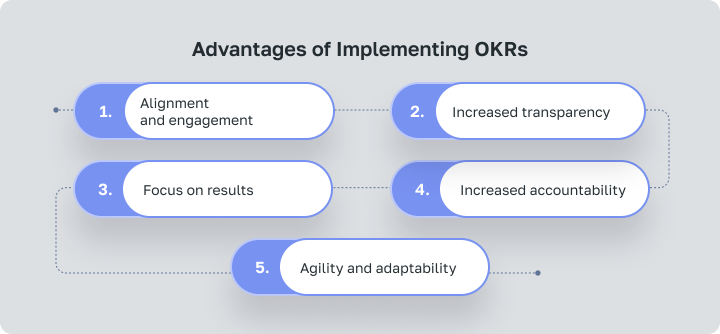
- Alignment and engagement: OKRs promote cross-departmental alignment by linking corporate, team and individual goals to measurable results.
- Increased transparency: OKRs help foster a culture of openness by making goals and key results visible to all team members.
- Focus on results: OKRs encourage organizations to define success in terms of real results, not just the completion of tasks.
- Increased accountability: Because OKRs require setting specific and measurable goals, they help increase accountability by making it clear who is responsible for what results.
- Agility and adaptability: OKR agile approach support a dynamic planning process that can quickly adapt to change. The short planning cycles allow teams to adjust their strategies in response to changes in the business environment or priorities.
Common Pitfalls in OKR Implementation
When it comes to setting goals, it’s easy to get carried away and make some common mistakes. Fortunately, these mistakes are also not difficult to avoid if you think about them in advance: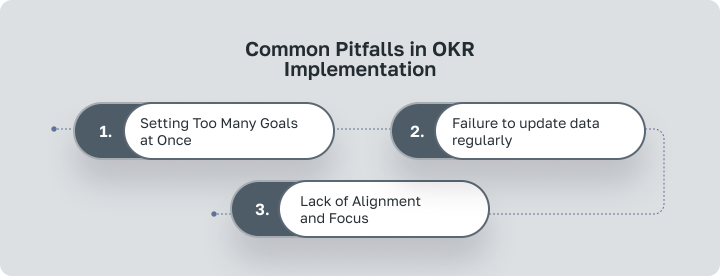
 Setting Too Many Goals at Once
Setting Too Many Goals at Once
Team members feel overwhelmed and don’t know what to focus on when you set too many goals. Set only 2 – 3 high-priority goals and then move on to the next ones to avoid this mistake.
 Failure to update data regularly
Failure to update data regularly
Update your data regularly. This is important to keep your goals and key results effective. Failing to do so will make it difficult to know if you are progressing toward them and to make timely adjustments.
Set a schedule for reviews and updates and stick to it to avoid this mistake.
 Lack of Alignment and Focus
Lack of Alignment and Focus
Goals and key results work best when the team has alignment and focus on the process. A simple training session is all that is needed so that everyone in the company has an understanding of what OKRs are and how they work.
If you focus on quality rather than quantity, you can easily avoid these mistakes. Also, be realistic about what you think you can accomplish. This will help get the team aligned and buy in.
Measuring Success: OKR Grading and Evaluation
How do you know if goals are being achieved according to plan? The use of key performance indicators (KPIs) is an effective way to monitor progress toward key objectives.

Key Performance Indicators (KPIs) are metrics that teams use to measure their performance against their goals when viewed in the context of OKRs. In other words, KPIs are fully useful in conjunction with OKRs.
In order for KPIs to work, they must be:
- Clearly defined and understood;
- Measured and trackable;
- Achievable with reasonable effort.
- Relevant to the goals you are trying to achieve.
- Have a specific time frame for completion.
Role of Reporting in OKR Tracking
In tracking goals and key results, reporting plays an important role. You can share your progress with colleagues and get their feedback, synchronizing your efforts.
Reporting can be done formally or informally:
- Formal reporting is usually done according to established procedures and formats.
- Informal reporting can be more free-form and informative in nature.
Worksection: Platform for project alignment with OKR
The Worksection project management system is ideal for teams that want to start or continue working effectively with OKRs. You can set, track and evaluate goals and key deliverables in detail with Worksection’s tools.
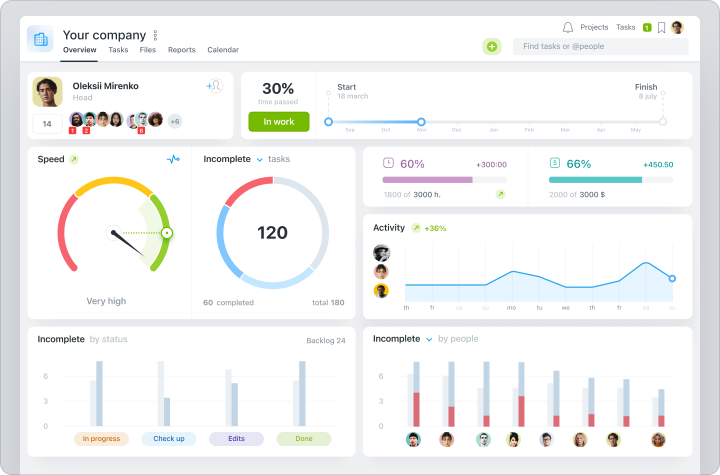
Worksection has powerful features for the following tasks:
Setting Objectives and Key Results
Using Worksection is a convenient way to define and document goals. You can set up one big goal and then break it down into almost any number of smaller tasks and even subtasks.

Tracking Progress
Easily monitor project progress with a dashboard. Detailed infographics show the speed and success of the project. You can visually track progress with charts, timers, and other useful information. Meanwhile, access to up-to-date information and reports can be tailored with different levels of access.
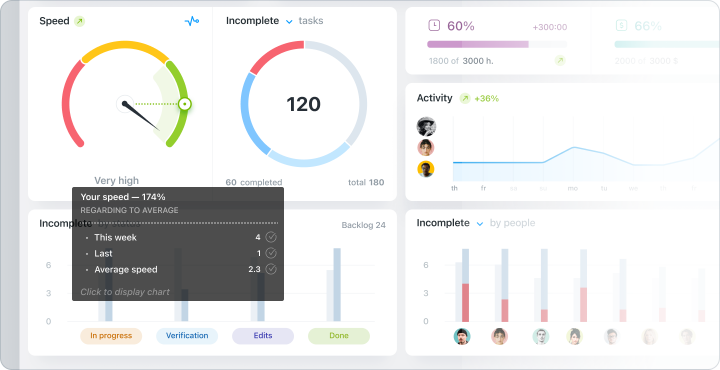
Flexibility and Adaptability of OKR Display:
All Worksection tools are highly customizable and adaptable to the specifics of a particular team and its tasks. This is optimal for tracking and adjusting Objectives and keeping them up-to-date.
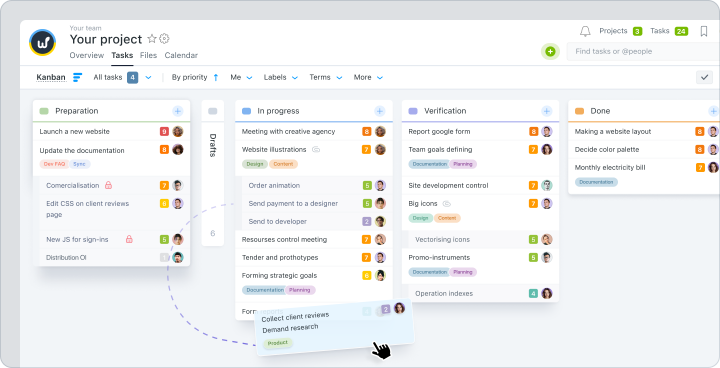
Conclusion
OKR is a powerful methodology that can help an organization achieve its goals. It’s important to use team resources wisely and find tools that automate all stages of work when developing objectives and key results.
Such tools are at the heart of the Worksection project management system. They allow you to customize workflows for each company, taking into account the tasks of different teams.
With its flexibility and adaptability, Worksection allows you to set and achieve any goals you want, tracking objectives and managing teams at all levels of your organization.
Sign up now to achieve your goals faster!